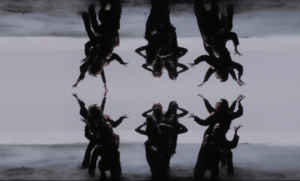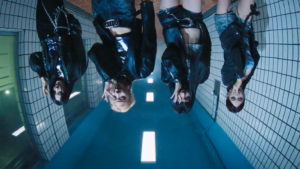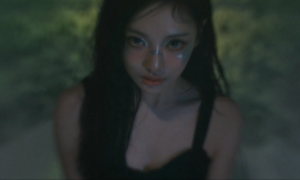
Whether or not we’re officially in the 5th generation of K-pop now (and to be honest, I’m too old to really pay any attention to these debates), a clear divide is apparent in the styles of the 4th gen. As a genre, K-pop has normally lent towards the maximalist in musical terms, but the recent success of groups like NewJeans and Illit—regardless of the drama—have swerved trends in the opposite direction. The past year or so has seen some groups making simpler, calmer, more lo-fi songs: Le Sserafim’s “Easy” springs to mind. This trend certainly adds an element of freshness and familiarity to the Y2K sound.
But it is clearly not a trend that has won over every group. If the pendulum swung last year to a minimal sound, Aespa have always been ready and waiting to catch it on its return. Favouring high concept, lore-heavy approaches, their music is a confident collage of sounds that is anything but small. In “Armageddon”, the second title track from their first full studio album of the same name, the quartet continue to walk this path. An old-school R&B inflected slice of bombastic pop, the song and MV display Aespa’s utter comfort with the big and the bold.
The MV opens, unsurprisingly, in dramatic fashion. A close-up shot of Karina is quickly interrupted by Winter’s hand covering her mouth, as the camera swirls around a dark room suddenly lit by floodlights and a crack in the ceiling. Everything starts to crumble before the scene changes, revealing a sequence of abstract and derelict backdrops. From what look like abandoned warehouses and empty diners, to endless underground corridors and spaceship-esque soundstages, the world of “Armageddon” is both futuristic and dilapidated. It’s a fitting mood for the title of this song, and the suddenness of the MV’s opening moments is matched by a constant visual creativity throughout.

In common with a lot of Aespa’s work, there are multiple cuts in the MV to computer-graphic laden scenes of the girls and the extra-dimensional world that presumably represents the ‘kwangya’ of their lore. Sometimes these shots are reached with trippy wormhole-style transitions, and often utilise the swooping, kinetic camerawork of the MV’s opening. These graphics, often spiky, metallic shapes that echo the style of Aespa’s general brand, are exciting visual beats that punctuate the dance scenes and solo shots.
That is not to say that there is no visual flare outside these more striking moments. “Armageddon” is completely unafraid to be experimental in its cinematography. Aside from the dynamic camera movements, there are a plethora of other effects on display. From split screens with different members on each side to fish eye lenses, and from upside down shots to fully mirrored dance sequences, the eye is constantly moving around while watching this MV. At some points, these shots become actively surreal, with kaleidoscopic effects creating swirling copies of Ningning as she sits regally in a grey leather chair, and Giselle’s face being replaced with a colourful constellation.

It’s a clever choice to be this bold in the framing of the MV, as it emphasises the fun in the music itself. Though the lyrics on their own don’t really go any further than the usual empty K-pop bombast (saying that, props to the girls for making “chitty bang bang” sound cool), the trilling hooks around the chorus echo the techno edge to the visual landscape. Also, it’s no secret that Aespa have the vocal prowess to pull off strong and powerful high notes. Here, these belts and runs feel as grand as the huge structures that glimmer in the abstract sections of the MV, and they match well with the sweeps of the camera.
The general tone of the song itself is a little edgier and more grandiose than its album mate “Supernova”. The chanting of “Aw wayo wayo” swaggering next to the slow delivery of “I’ma get it done” provides a darker and cooler tinge than the hyperpop of the album’s first title track. To match this, the colour palette of “Armageddon” offers a world of blacks, greys and neutrals in contrast to the brightness of “Supernova”. The backdrops are also mostly indoors, or in the extra-dimensional plane, and through these colour choices become grungy and almost techno-punk. This is only emphasised by the flashes of CCTV-style shots and face captures, giving a Matrix-like sense of a crumbling world with nefarious machines impacting its downfall.

This techno-punk aesthetic slips through to the styling of the MV too. I would debate whether the combination of hot pants and crop tops really fits this vibe (come on K-pop stylists, there are other items of clothing), but the heavy black and grey certainly does. There are piercing-style adornments on their faces, studded chokers, chain belts and fishnet sleeves galore here. In the extra-dimensional sequences these outfits get grander whilst maintaining the neutral colour palette. For instance, Giselle is seen sporting a black leather dress with impressively exaggerated shoulders, whilst Ningning’s grey draped number looks like something worn by a queen in the Star Wars universe.
The makeup used to accessorise these particular scenes only adds more drama to them. Whilst in the main dance sequences the members wear smudged silver glitter across their eyes, nose and upper cheeks, in the ‘kwangya’ scenes metallic crowns and pieces are added to their faces. In Winter this gives a fairy-like appearance, whilst Karina appears more like an alien with pieces adorning her cheekbones, Giselle looks regal and Ningning becomes almost mechanical with a piece covering her eye. The extravagance of this styling is a stark and welcome contrast to the plainer looks in the main sequences of the MV, reminding us that Aespa are anything but simple.

That is the ultimate takeaway from the “Armageddon” MV: Aespa simply don’t do minimalism. Whilst this title track hits a slower tempo and more stripped-back aesthetic mode than “Supernova”, it is still the other side of the same coin. It’s an entertaining look into how to add flare through camerawork and framing, with the members at the centre more than squaring up to the swaggering demands of the song and the surrealism in the visuals.
As part of Aespa’s first full studio album after almost four years, it’s an exciting glimpse into what they can achieve in the future. As the drama surrounding NewJeans and Illit continues to overshadow the minimalist end of the spectrum, “Armageddon” shows that Aespa are unbothered. Perhaps they are even moving the K-pop needle back to their over-the-top, extravagant, maximalist style.
(YouTube. Lyrics via Genius. Images via SM Entertainment.)
0 Comments